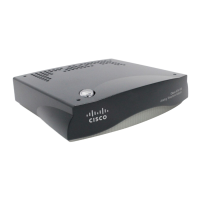CHAPTER
9-1
Cisco ATA 186 and Cisco ATA 188 Analog Telephone Adaptor Administrator’s Guide (H.323)
OL-4008-01
9
Troubleshooting
This section describes troubleshooting procedures for the Cisco ATA:
• General Troubleshooting Tips, page 9-1
• Symptoms and Actions, page 9-2
• Installation and Upgrade Issues, page 9-3
• Debugging, page 9-4
• Frequently Asked Questions, page 9-5
• Contacting TAC, page 9-7
Note The term Cisco ATA is used throughout this manual to refer to both the Cisco ATA 186 and the
Cisco ATA 188, unless differences between the Cisco ATA 186 and Cisco ATA 188 are explicitly stated.
General Troubleshooting Tips
The suggestions in this section are general troubleshooting tips.
• Make sure that the DHCP server is operating correctly. Note that the function button blinks slowly
when the Cisco ATA attempts to acquire the DHCP configuration.
• If the green activity LED is not flashing after you connect the Ethernet cable, make sure that both
the power cord and the Ethernet connection are secure.
• If there is no dial tone, make sure that the telephone line cord from the telephone is plugged into the
appropriate port on the Cisco ATA. Make sure that your Cisco ATA is properly registered on your
Call Control system. Test another phone; if this phone does not work either, there may be a problem
with the current configuration or with the Cisco ATA.
• A busy tone indicates that the party you called is not available. Try your call again later. A fast-busy
tone indicates that you dialed an invalid number.
• After power up, if the function button continues to blink slowly, the Cisco ATA cannot locate the
DHCP server. Check the Ethernet connection and the availability of the DHCP server.
• The DHCP server should show an incoming request from the MAC address listed on the product
label or given by the voice prompt.
• If you place a call to another IP telephone, detect ringing, and the called party answers but you
cannot detect the speaker’s voice, verify that the Cisco ATA and the other IP telephone support at
least one common audio codec: G.711A-law, G.711µ-law, G.723.1, or G.729A.

